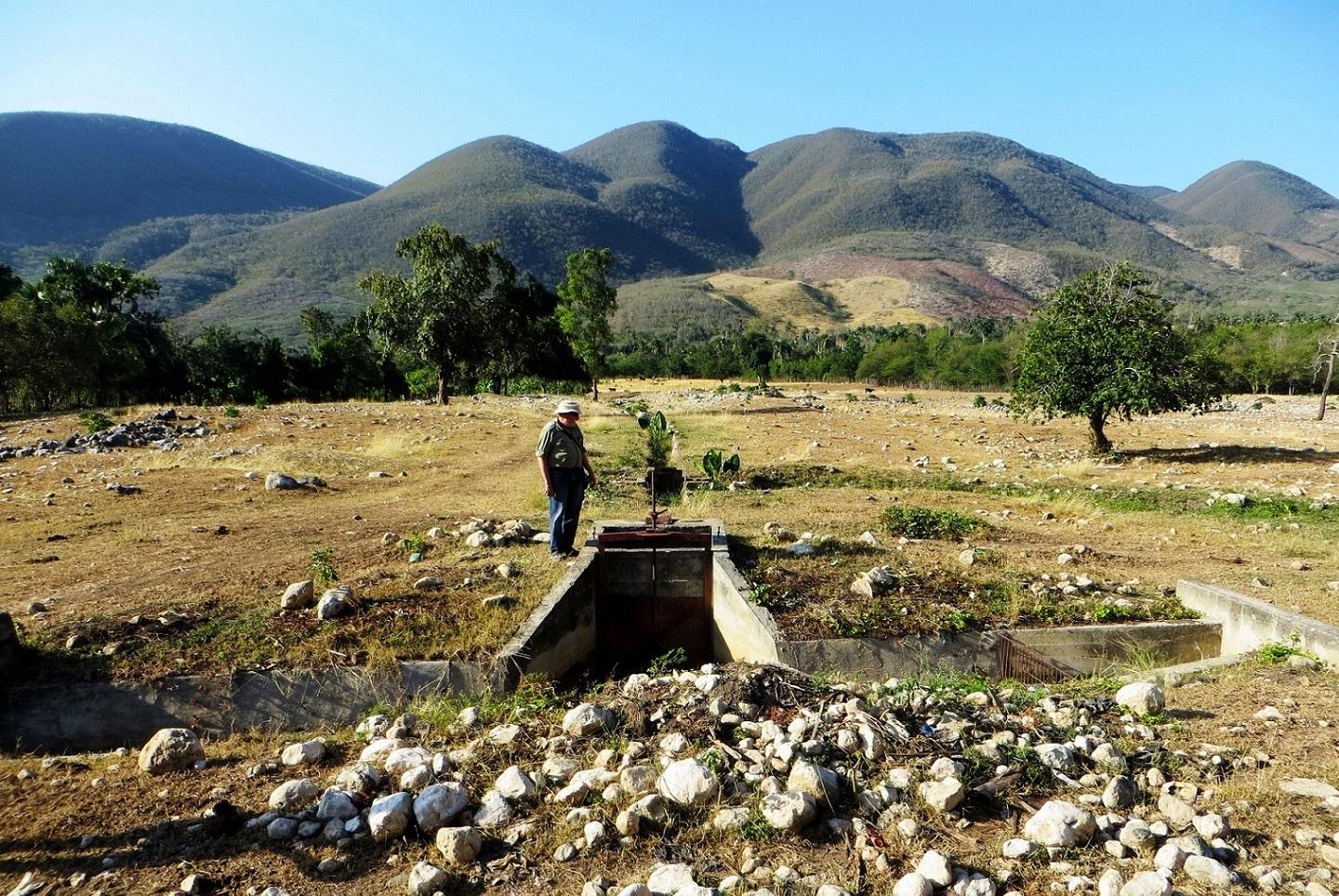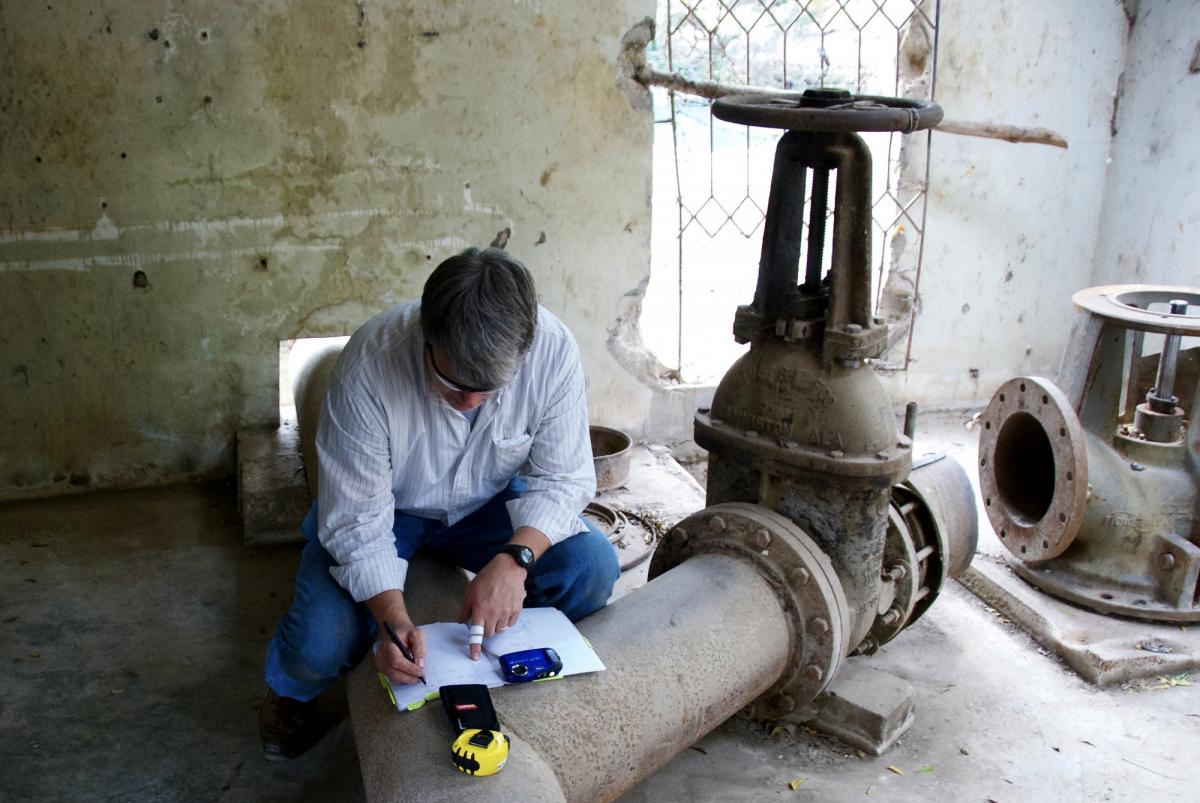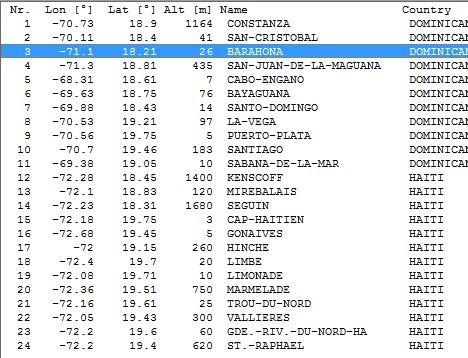
The irrigation system in Guayabal, Dominican Republic, has not functioned for 14 years. Since its failure, agricultural production has diminished in the area from reasonably productive to subsistence or less. Earlier this year, EMI was asked to review the situation to determine how to restore irrigation water delivery for the ongoing economic benefit of this community.
Guayabal is located in the dry southwestern part of the country, not far from the Haiti border. It has a population of about 2,500 and is (or was) largely supported by agriculture. The town and the agricultural area is supplied with water from a large spring with an estimated flow of 2.0 to 2.5 m3/s, depending on the season. This spring is the source of the Rio de Guayabal, and is more than adequate for the 166 hectares of irrigable land. However, this spring surfaces in a small pool below the elevation of the town and agricultural area. The government-built irrigation system used two 300 hp turbine pumps to lift water into a concrete-lined canal for distribution to the surface-irrigated fields. The basic cause of failure in this irrigation system was reportedly low voltage in electrical supply to the pumps, which caused the motors to burn-out.


In the subsequent analysis and pumping solution by the EMI team, the fundamental question was ‘how much irrigation water needs to be pumped?’ Estimating irrigation water demand for agriculture is a common element of many EMI projects. The following overview is given as a guide to the process:
Like all living organisms, plants need water to survive. Irrigated agriculture is required when the existing climatic conditions do not supply adequate water for the plants. For a given crop situation, water application or “irrigation scheduling” must answer three questions:
-
How to apply water?
Generally, the method of irrigation is predetermined in the developing world. It is the method under current use that is understood by farmers. Changing the irrigation method is often a costly and intensive process. This is because it involves extensive training in the new method to ensure efficient operation and maintenance. The irrigation methods in Guayabal included surface irrigation (the majority of the area) and micro-sprinkler and/or drip irrigation for higher-value crops.
-
When to apply water?
Irrigation systems are generally designed to meet the maximum water requirement. Though this design phase is a “one-time” event, the management of the irrigation system is an “ongoing” event. The adjustment of water application is required to meet the changing needs of a crop as it develops, and to account for rainfall events which occur.
-
How much water to apply?
This is the typical EMI project design problem. Crop water use is known as evapotranspiration (ET). As the name implies, this is a combination of the processes of evaporation and transpiration. Evaporation is the direct transition of water from a liquid to a vapor state – either from the soil or from a water surface (in the case of rice). Transpiration is the plant process whereby water is taken into the plant via the roots and translocated within the plant through the stems and leaves, finally entering the atmosphere as water vapor. Both these processes remove water from the soil and contribute to the water use estimate. Both processes are also influenced by climatic variables: temperature, relative humidity, wind speed, and solar radiation. In order to obtain an estimate of plant water use, these variables must be known or estimated.
Estimating ET solely from climatic variables gives potential ET (ETo). This is the maximum ET that can occur according to the energy inputs for a given situation. This can be estimated from evaporation from an open water surface. For instance, an evaporation pan allows for changes in elevation of the water surface to be measured over time. The actual crop ET (ETc) is given by a combination of the potential ET (ETo) and a crop factor, Kc, which is dependent on the particular crop and its growth stage. There are published values available for the Kc factors for crops under different conditions. The resulting actual crop ET, ETc, is given by:
ETc = Kc * ETo
Much effort has been put into developing accurate estimates of ETo, and the United Nations Food and Agriculture Organization (FAO) has made these available. The best known and most widely used is CLIMWAT, in which estimates of ETo can be determined for locations around the world. Using weather data collected from meteorological stations, airports, etc., CLIMWAT develops a weather data file which can be entered into another FAO program, CROPWAT. This program calculates ETc estimates for given crops in the chosen location.
While this approach is extremely valuable in getting initial estimates of ETo and ETc before arriving at a field site, it has limitations. For example, the project site in Guayabal had a dry, upland semitropical climate and the necessary weather data were unavailable. In CLIMWAT, the closest data station was Barahona – a coastal environment with much more humid conditions. In addition, detailed information about future Guayabal agriculture plans, such as crops to be grown, areas devoted to each crop, and proposed planting & harvest dates were not available. Accordingly, CROPWAT could not be used. Observation of agricultural production in the surrounding area showed a wide variety of crops could be grown. At present, with limited water for irrigation available, people were primarily growing maize and beans.


Under these circumstances, it is necessary to use a simplified approach. This involves estimating the average crop ET for the climatic conditions prevalent on the site. In the Guayabal situation, a table of estimates for average crop ET in different conditions was used. The average ETc was selected to be 6.4 mm/day (or 0.25 in/day). In this climatic area, this is peak evapotranspiration (ET) for most of the crops considered.
With an ETc selected, the calculation of irrigation water demand can be performed. To add 1 mm of water per hectare of land, 10 m3 of water are required. Therefore, 64 m3/day is needed per hectare of irrigated land. The area of irrigable land in the Guayabal irrigation system has been determined to be 166.2 ha. Assuming that 50% of the area needs to be irrigated at any one time, the water required is 5,318 m3/day. Assuming 80% distribution efficiency and 50% application efficiency, the gross water volume required is 13,300 m3/day. This figure was used as the basis for the pumping solution proposed by EMI to restore the Guayabal irrigation system.

Table of Approximate ET rates for Different Climatic Conditions
| Climate | Max ET | |
|---|---|---|
| Cool Temperature | 0.15 | 3.8 |
| Warm Temperature | 0.20 | 5.0 |
| Warm Semi-Tropical | 0.25 | 6.4 |
| Hot Tropical | 0.30 | 7.6 |
| Hot Dry Desert | 0.35 | 8.9 |
| in/day | mm/day | |
Note: These estimated values are derived from various sources and from the author’s experience. These estimates should only be used when more specific information is not available.